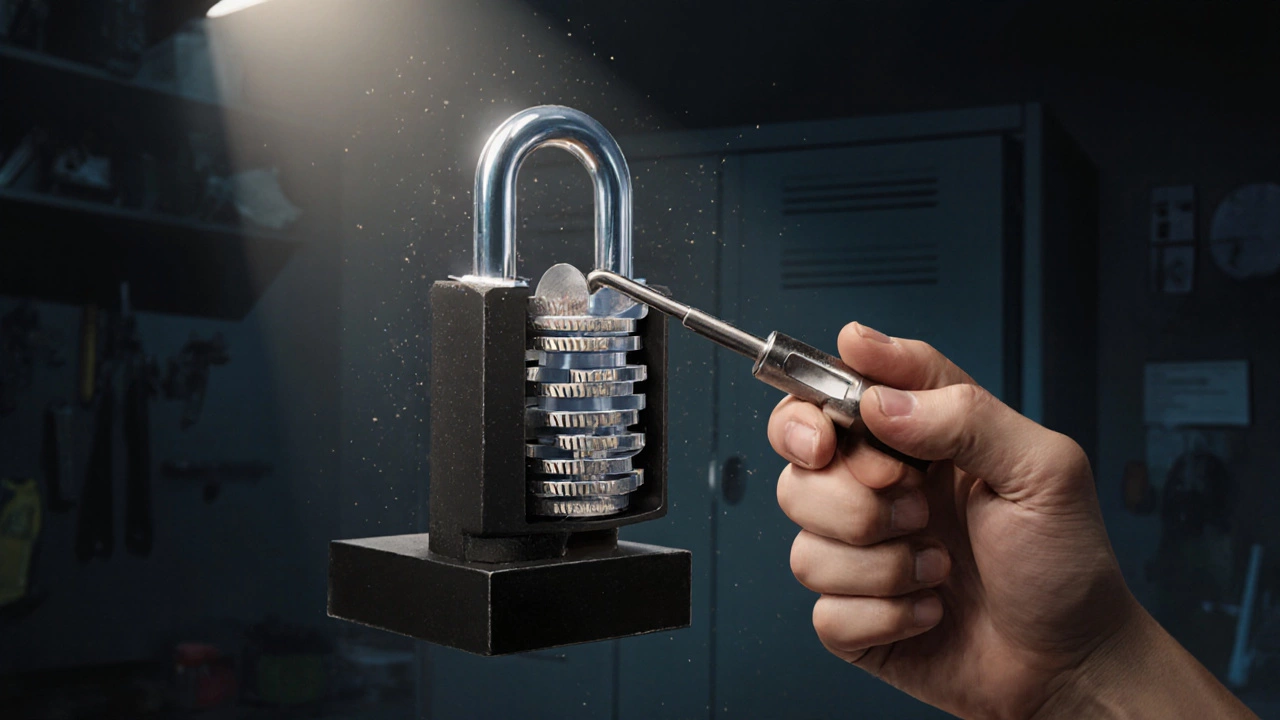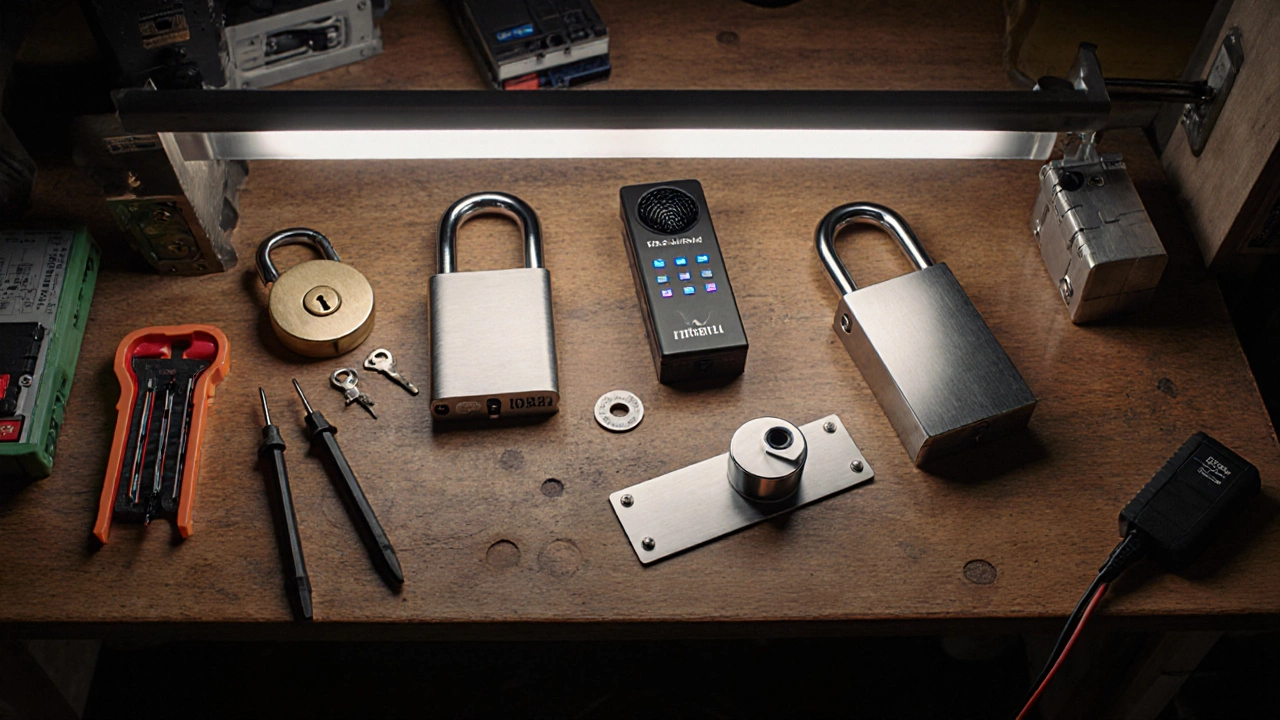IS 15688 Grade 4 Lock Security Calculator
Verify if a lock meets Indian Standard IS 15688 Grade 4 requirements. This standard specifies minimum security metrics for high-security locks used in commercial and sensitive applications.
Ever heard someone say, “That lock can’t be opened”? In the world of locksmithing, the claim is both a brag and a challenge. For trainees in India, knowing which lock really puts a stop to picking, drilling, or bumping isn’t just trivia-it shapes the tools you learn, the jobs you take, and the safety you guarantee. Below we break down the locks that earn the "unopenable" label, why they earn it, and how you should approach them in a training program.
Quick Takeaways
- Discdetainer and magnetic locks are the toughest to pick without specialised tools.
- Electronic smart locks add encryption, making physical bypass almost impossible.
- Key control systems prevent master‑key misuse, turning a standard pin tumbler into a high‑security barrier.
- Even the best locks can be defeated with the right equipment; training focuses on recognizing limits.
- Indian Standard IS15688 defines high‑security specifications for commercial doors.
Let’s dig into the locks that most often earn the “cannot be opened” reputation and see what makes them stand out.
Understanding the “Unopenable” Myth
First, a quick reality check: no lock is truly impossible to open. A determined attacker with unlimited time and resources can eventually defeat any mechanism. What we mean by “cannot be opened” is that, using standard locksmith tools and techniques taught in a high security lock is a lock designed with enhanced resistance to picking, drilling, and forced entry, featuring patented keyways, hardened steel inserts, and complex pin configurations, the lock resists common attacks.
Disc Detainer Locks - The “Impossible” Pick
Disc detainer locks, popular in aircraft and high‑security facilities, use rotating discs instead of pins. Each disc has a unique notch, and the key aligns all notches simultaneously. Because there’s no linear pin stack, traditional pick‑rake tools are ineffective.
Disc Detainer is a lock type that relies on stacked rotating discs, offering high resistance to picking and bumping. The key’s angular cuts must match each disc’s profile, making key duplication tightly controlled.
Training tip: practice using a dial‑disc pick set; it’s the only tool that can manipulate the discs, but success rates drop below 10% on a well‑engineered unit.
Magnetic Locks - The Silent Barrier
Magnetic locks (maglocks) use electromagnetic force to keep the door sealed. When power is cut, the lock releases; otherwise, a steel plate is held firmly against the frame.
Magnetic lock is an access control device that engages via an electromagnetic field, providing a smooth, keyless hold. Since there’s no mechanical keyway, the only way to open it without power is to cut the plate or disable the power supply.
In a locksmith course, you’ll learn to test the fail‑safe circuitry and to assess whether a backup battery meets safety standards.
Electronic Smart Locks - Code Meets Cryptography
Smart locks combine a motorised deadbolt with Bluetooth, Wi‑Fi, or RFID. The lock’s firmware validates encrypted tokens, meaning a physical key isn’t the only access method.
Electronic smart lock is a lock that integrates digital authentication, often with mobile apps, and stores encrypted credentials. Even if you drill the bolt, the motor will re‑engage unless the controller is disabled.
Hands‑on labs usually involve flashing firmware and testing for replay attacks - essential skills as smart locks flood the Indian market.

Biometric Locks - The Fingerprint Fortress
Biometric locks add a layer of identity verification. A fingerprint scanner or iris reader validates the user before releasing the latch.
Biometric lock is a security device that grants access only after matching biometric data, making physical lock‑picking irrelevant. The mechanical part is often a standard deadbolt, but the electronic verification makes bypass extremely difficult.
During training, you’ll explore how to calibrate sensors and how to deal with false‑reject rates, a common issue in humid Indian climates.
Key Control Systems - Turning a Simple Lock into a Fortress
A key control system doesn’t change the lock’s hardware but restricts key duplication through patented keyways and restricted key blanks.
Key control system is a management approach that uses restricted key blanks and centralised key issuance to prevent unauthorized copies. When paired with a high‑security pin tumbler, the result is a lock that feels “unopenable” to anyone without the proper key.
The most common brands in India-Mul‑T‑Lock, Medeco, and Abloy-offer comprehensive key control programs that you’ll encounter in a locksmith training program is an educational course that teaches lock mechanisms, tools, and legal standards for aspiring locksmiths.
Indian Standards - IS15688 Defines the Benchmark
When evaluating “unopenable” locks for commercial projects, refer to Indian Standard IS15688 is a national specification that outlines performance criteria for high‑security locks, including resistance to picking, drilling, and impact. The standard grades locks from 1 (basic) to 5 (high‑security). Most locks that claim unopenability meet at least Grade4.
During exams, trainees often compare lock specifications against IS15688 tables to prove compliance.
Comparison Table: How the Toughest Locks Stack Up
| Lock Type | Pick Resistance | Drill Resistance | Common Applications | Typical Price (INR) |
|---|---|---|---|---|
| Disc Detainer | Very High | High (hardened discs) | Aviation, high‑security vaults | 12,000‑25,000 |
| Magnetic Lock | Not applicable (no key) | Medium (steel plate can be cut) | Office buildings, hotels | 8,000‑18,000 |
| Electronic Smart Lock | High (crypto‑based) | Medium (motor can be jammed) | Residential, rentals | 6,000‑20,000 |
| Biometric Lock | High (no mechanical key) | Medium (deadbolt steel) | Data centers, labs | 15,000‑30,000 |
| Key‑Control Pin Tumbler | High (restricted keyway) | High (hardened steel pins) | Commercial offices, banks | 5,000‑12,000 |

Practical Tips for Locksmith Trainees
- Know the lock’s rating. Before attempting a bypass, verify the lock’s IS15688 grade - it tells you which tools are legal to use.
- Invest in a lock picking tool is a specialized instrument, ranging from rakes to semi‑automatic decoders, used to manipulate lock mechanisms set that includes a disc‑detainer pick for those stubborn locks.
- Practice the “cold‑picking” method on a dummy lock first - it builds feel without damaging the real unit.
- When dealing with smart locks, always test the power backup; cutting the power is often the fastest entry.
- Document every attempt. In India, a written report may be required for insurance claims or legal compliance.
When “Cannot Be Opened” Becomes a Legal Issue
In many Indian states, attempting to open a lock without the owner’s consent is a punishable offense under the Indian Penal Code. Training institutes stress the importance of obtaining a written authorization before any forced entry. The “unopenable” label should never encourage illicit behavior - it’s a benchmark for security, not a dare.
Future Trends - Will Any Lock Remain Unopenable?
As IoT devices proliferate, manufacturers are integrating AI‑driven anomaly detection into locks. Imagine a deadbolt that senses torque patterns and triggers an alarm if an unfamiliar tool is used. While such tech raises the bar, it also creates new vulnerabilities - firmware glitches, ransomware attacks, and supply‑chain compromises.
For students, staying updated with cybersecurity fundamentals will be as crucial as mastering a hook pick.
Frequently Asked Questions
Which lock is truly unpickable?
Disc detainer locks are considered the hardest to pick because they lack a linear pin stack. Only a specialized disc‑detainer pick set can manipulate them, and success rates are low on high‑grade models.
Can a magnetic lock be forced open?
Yes, but you need to either cut through the steel plate or disable the power supply. Without power, the electromagnet releases, so most installations include a fail‑safe emergency release.
Do smart locks eliminate the need for traditional locksmith skills?
Not at all. While smart locks reduce mechanical attacks, they introduce electronic vulnerability. Locksmiths now need to understand firmware, encryption, and battery management alongside classic pick techniques.
What does IS15688 Grade4 guarantee?
Grade4 requires a lock to resist picking for at least 5minutes, drilling for up to 3mm hardened steel, and impact forces of 50J. It also mandates key control measures.
How should a trainee document a forced‑entry attempt?
Include the lock model, IS rating, tools used, time taken, and outcome. A photo of the lock before and after, plus a signed authorization from the property owner, makes the report legally sound.
